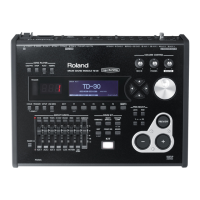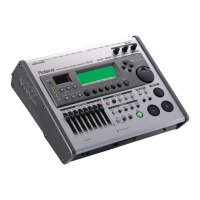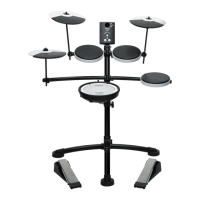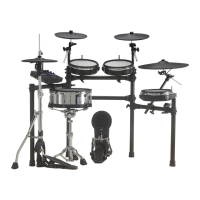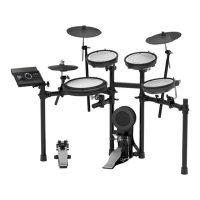51
Settings
3. Press a button from [F1] (THRESHOLD) to [F4]
(POSITION) to select the item you want to edit.
Button Explanation
[F1] (THRESHOLD)
button
Congures the detailed settings for the pad
sensitivity.
[F2] (RIM) button Congures the detailed rim shot settings.
[F3] (SCAN) button
Congures the detailed trigger signal detection
settings.
[F4] (POSITION)
button
Congures the detailed strike point detection
settings.
4. Select the pad to congure (p. 29).
5. Use the cursor buttons to select a parameter, and use
the [-] [+] buttons or the dial to edit the value.
MEMO
To return to the default values, press the [F5] (DEFAULT) button.
Trigger parameters (with the exception of certain parameters such
as crosstalk cancellation) are set to the default value.
For details, refer to “Data List” (PDF).
Making Detailed Settings for Digitally-
Connected Pads
The rst time that you connect a pad that supports digital connection,
the following settings are automatically set to values that are optimal
for each pad, so it is normally not necessary to specify them. Edit these
settings if you want to make more detailed adjustments.
Reference
For details on the parameters that can be edited, refer to “Data List”
(PDF).
1. In the DIGITAL TRIGGER IN screen (p. 49), press the
[F5] (ADVANCED) button.
The DIGITAL TRIGGER ADVANCED screen appears.
2. To select the pad for which to make settings, either
strike that pad or press the cursor buttons.
3. Use the cursor [
J
] button to move the cursor to the
Advanced Setting parameters.
4. Use the cursor buttons to select a parameter, and use
the [-] [+] buttons or the dial to edit the value.
* The parameters that you can edit will dier depending on the pad.
MEMO
To return to the default values, press the [F5] (DEFAULT) button.
Trigger parameters (with the exception of certain parameters such
as crosstalk cancellation) are set to the default value.
For details, refer to “Data List” (PDF).
Viewing Trigger Information for Each Pad
You can view realtime information that shows the force (velocity) with
which each pad is struck, how far the hi-hat is open, and the strike
position on the snare, ride cymbal, toms, and AUX.
MEMO
Performance data received via the MIDI IN connector is also
displayed.
1. Press the [TRIGGER] button.
2. Press the PAGE [DOWN] button to display page 3 (TRIG
MONITOR).
3. Press the [F1] (TRIG) button.
The TRIGGER MONITOR screen appears.
Velocity meter
(Indicates the force (velocity) of the strike.)
Indication Explanation
K KICK
S SNARE
1–4 TOM1–4
H HI-HAT
Indication Explanation
C CRASH 1, 2
R RIDE
A AUX1–4
4. Strike the pads.
The meter indications in the screen will move in realtime, allowing
you to view the following information.
Indication Explanation
HI-HAT
Shows how far the hi-hat is open. The indicator
will move toward “OPEN” as the hi-hat opens,
and toward “PRESS” as it closes.
POSITION
If the pad supports strike point detection, the
strike point for the pad is shown.
Also, when the VH-14D is connected, the left/
right strike points for the cymbals are shown.
The indicator moves toward “LEFT” as the strike
moves closer to the left side of the pad, and
toward “RIGHT” as the strike moves closer to the
right side of the pad.
CHOKE
The “CHOKE” icon appears when the cymbal is
choked.
The CHOKE icon appears when you use the
choke technique on a pad that supports
choking.
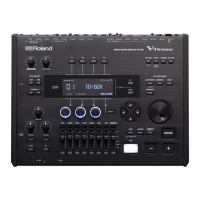
